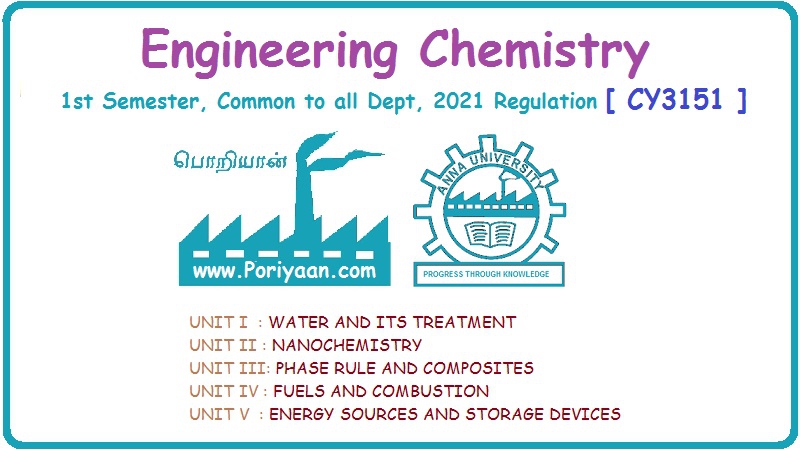Engineering Chemistry: Unit II: Nanochemistry
Preparation of Nanomaterials
The following two approaches are used for the synthesis of nanomaterials. 1. Top-down process (or) Physical (or) Hard methods. 2. Bottom-up process (or) Chemical (or) Soft methods.
PREPARATION OF
NANOMATERIALS
The following two approaches are used for the synthesis of
nanomaterials.
1. Top-down process (or) Physical (or) Hard methods.
2. Bottom-up process (or) Chemical (or) Soft methods.
1. Top-down process
Top-down process involves the conversion of bulk materials into
smaller particles of nano-scale structure.
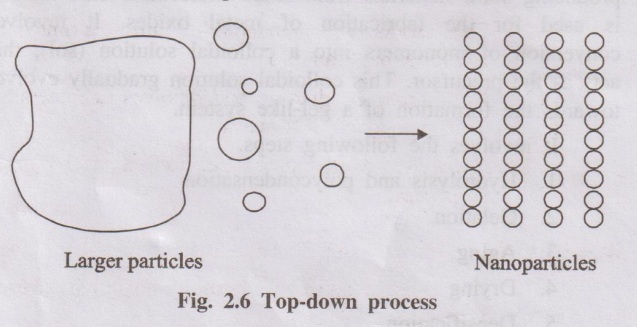
Fig. 2.6 Top-down process
2. Bottom-up process
Bottom-up process involves building-up of materials from the
bottom by atom by atoms, molecule by molecule or cluster to the nanomaterials.
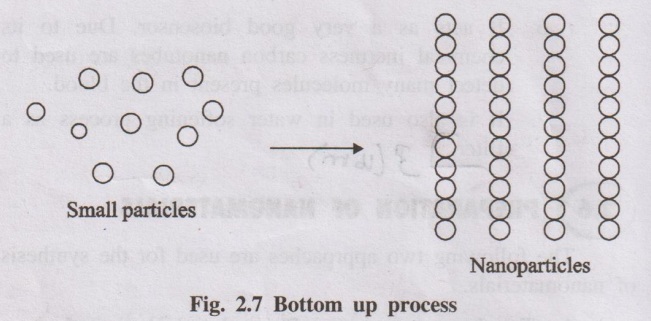 Fig. 2.7 Bottom up
process
Fig. 2.7 Bottom up
process
3. Important Preparations
1.
Sol-Gel process
The sol-gel process is a wet chemical technique also known as
chemical solution deposition. It is the method for producing solid materials
from small molecules. This method is used for the fabrication of metal oxides.
It involves conversion of monomers into a colloidal solution (sol), that acts
as the precursor. This colloidal solution gradually evolves towards the formation
of a gel-like system.
It involves the following steps.
1. Hydrolysis and polycondensation
2. Gelation
3. Aging
4. Drying
5. Densification
6. Crystallization
The volume fraction of particles (particle density) may be slow
that a significant amount of fluid need to be removed for the gel-like
properties to be recognized. It is done by two ways,
(i) Sedimentation
The solution is allowed to keep for some time for sedimentation to
occur and then pour off the remaining liquid.
(ii) Centrifugation
Centrifugation can also be used to accelerate the process of phase
separation.
Drying and densification
Removal of the remaining liquid (solvent) is done by drying
process, which accompanied by shrinkage and densification.
Firing (or)
crystallization
A thermal treatment (firing) is necessary to enhance mechanical
properties and structural stability via sintering, densification.
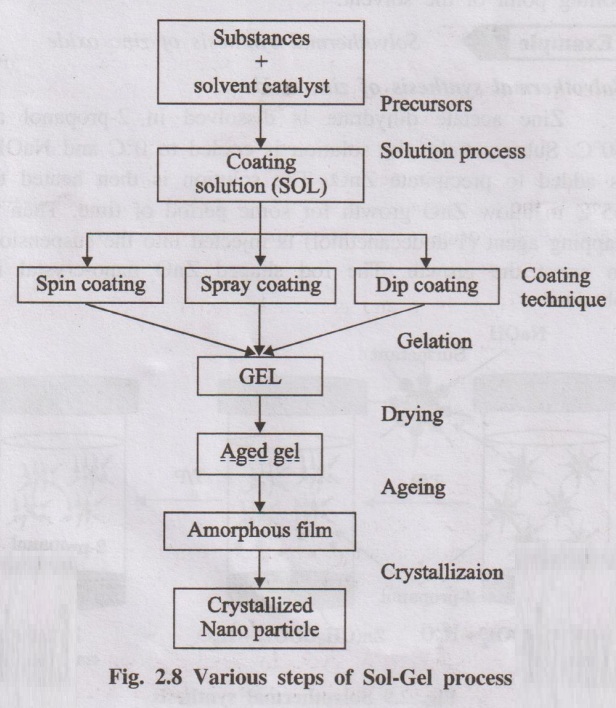
Fig. 2.8 Various steps of Sol-Gel process
2. Solvothermal Synthesis
Solvothermal synthesis involves the use of solvent under high
temperature (between 100°C to 1000°C) and moderate to high pressure (1 atm to
10,000 atm) that facilitate the interaction of precursors during synthesis.
Method
A solvent like ethanol, methanol, 2-propanol is mixed with certain
metal precursors and the solution mixture is placed in an autoclave kept at
relatively high temperature and pressure in an oven to carry out the crystal
growth. The pressure generated in the vessel, due to the solvent vapour,
elevates the boiling point of the solvent.
Example : Solvothermal synthesis of zinc oxide
Solvothermal synthesis
of zinc oxide
Zinc acetate dihydrate is dissolved in 2-propanol at 50°C.
Subsequently, the solution is cooled to 0°C and NaOH is added to precipitate
ZnO. The solution is then heated to 65°C to allow ZnO growth for some period of
time. Then a capping agent (1-dodecanethiol) is injected into the suspension to
arrest the growth. The rod shaped ZnO nano-crystal is obtained.
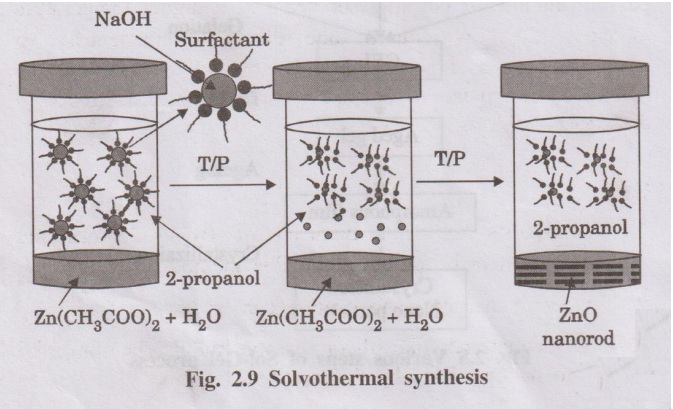
Fig. 2.9 Solvothermal synthesis
3. Laser ablation
In laser ablation technique, high-power laser pulse is used to
evaporate the material from the target. The stoichiometry of the material is
protected in the interaction.
The total mass ablated from the target per laser pulse is referred
to as the ablation rate.
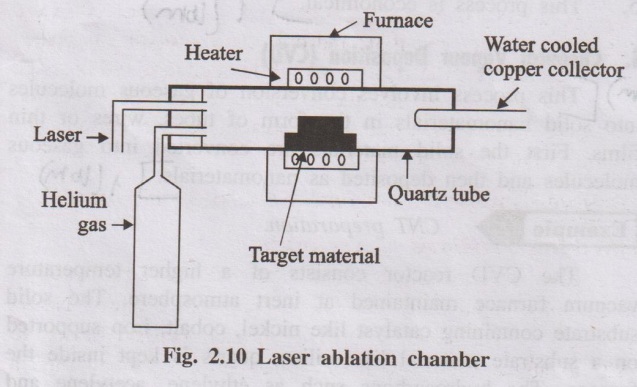
Fig. 2.10 Laser
ablation chamber
This method involves vapourisation of target material containing
small amount of catalyst (nickel or cobalt) by passing an intense pulsed laser
beam at a higher temperature to about 120°C in a quartz tube reactor.
Simultaneously, an inert gas such as argon, helium is allowed to pass into the
reactor to sweep the evaporated particles from the furnace to the colder
collector.
Uses
1. Nanotubes having a diameter of 10 to 20 nm and 100 um can be
produced by this method.
2. Ceramic particles and coating can be produced.
3. Other materials like silicon, carbon can also be converted into
nanoparticles by this method.
Advantages of laser
ablation.
1. It is very easy to operate.
2. The amount of heat required is less.
3. It is eco-friendly method because no solvent is used.
4. The product, obtained by this method, is stable.
5. This process is economical.
4. Chemical Vapour Deposition (CVD)
This process involves conversion of gaseous molecules into Solid
nanomaterials in the form of tubes, wires or thin films. First the solid
materials are converted into gaseous molecules and then deposited as
nanomaterials.
Example : CNT preparation.
The CVD reactor consists of a higher temperature vacuum furnace
maintained at inert atmosphere. The solid substrate containing catalyst like
nickel, cobalt, iron supported on a substrate material like, silica, quarts is
kept inside the furnace. The hydrocarbons such as ethylene, acetylene and nitrogen
cylinders are connected to the furnace.
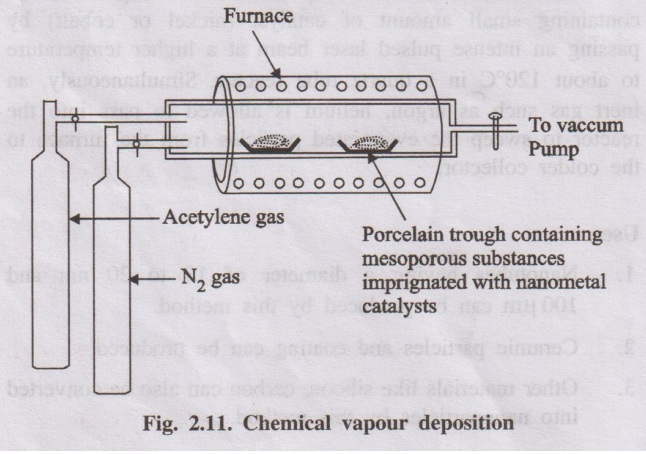
Fig. 2.11. Chemical vapour deposition and
Carbon atoms, produced by the decomposition at 1000°C, condense on
the cooler surface of the catalyst.
As this process is continuous, CNT is produced continuously.
Types of CVD Reactor
Generally the CVD reactors are of two types
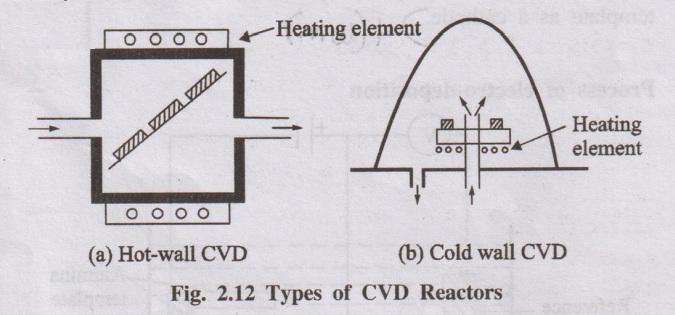
Fig. 2.12 Types of CVD Reactors
1. Hot-wall CVD
Hot wall CVD reactors are usually tubular in form. Heating is done
by surrounding the reactor with resistance elements.
2. Cold-wall CVD
In cold-wall CVD reactors, substrates are directly heated
inductively while chamber walls are air (or) water cooled.
Advantages of CVD
1. Nanomaterials, produced by this method, are highly pure.
2. It is economical.
3. Nanomaterials, produced by this method, are defect free.
4. As it is simple experiment, mass production in industry can be
done without major difficulties.
5. Electro-deposition
(or) Electrochemical deposition
Electro-deposition is an electrochemical method in which ions from
the solution are deposited at the surface of cathode. Template assisted
electro-deposition is an important technique for synthesizing metallic
nanomaterials with controlled shape and size. Array of nano-structured
materials with specific arrangements can be prepared by this method using an
active template as a cathode.
Process of electro-deposition
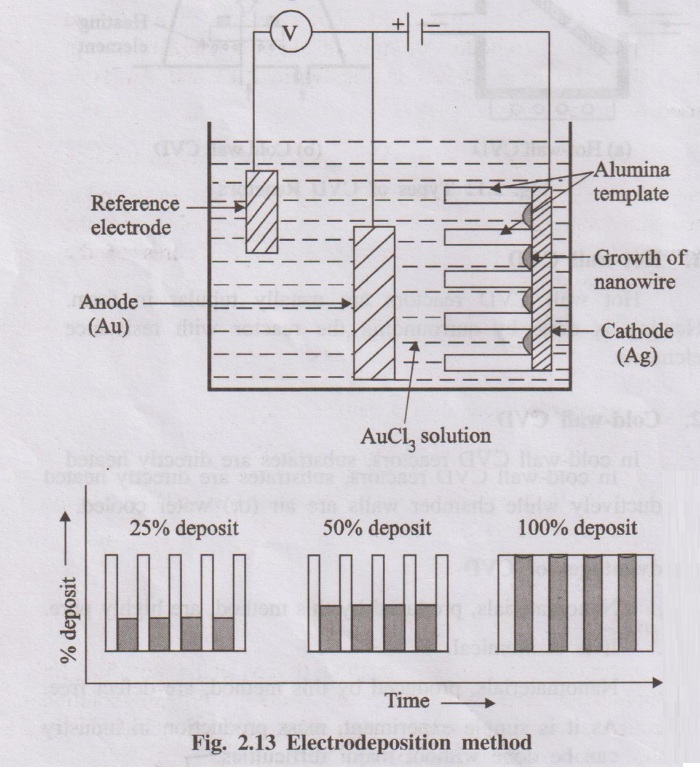
Fig. 2.13 Electrodeposition method
The cell consists of a reference electrode, specially designed
cathode and anode. All these electrodes are connected with the battery through
an, voltmeter and dipped in an electrolytic solution of a soluble metal as
shown in figure. When the current is passed through the electrodes of template,
the metal ions from the solution enter into the pores and gets reduced at the
cathode, resulting in the growth of nanowire inside the pores of the template.
Example : Electrodeposition
of Gold on Silver
Nanostructured gold can be prepared by the electrodeposition
technique using gold sheets as an anode and silver plate as a cathode. An array
of alumina template is kept over the cathode as shown in the figure 2.13 and
AuCl3 is used as an electrolyte.
When the current of required strength is applied through the
electrodes, Aut ions diffuse into the pores of alumina templates and gets
reduced at the cathode resulting in the growth of nanowires (or) nanorods
inside the pores of the alumina templates.
Advantages of Electro-deposition
1. This method is relatively cheap and fast.
2. Complex shaped objects can be coated.
3. The film or wire obtained is uniform.
4. Metal nanowires including Ni, Co, Cu and Au can be fabricated
by this method.
6. Electrospinning
Definition
Electrospinning is a method of producing ultrafine (in nanometers)
fibres by charging and ejecting a polymer solution through a spinneret under a
high-voltage electric field and to solidify (or) coagulate it to form a
filament.
Components
1. A high voltage power supply.
2. A polymer reservoir that can maintain a constant flow rate of
solution.
3. A conductive needle, as polymer source, connected to the high
voltage power supply.
4. A conductive collector (plate, drum, etc.)
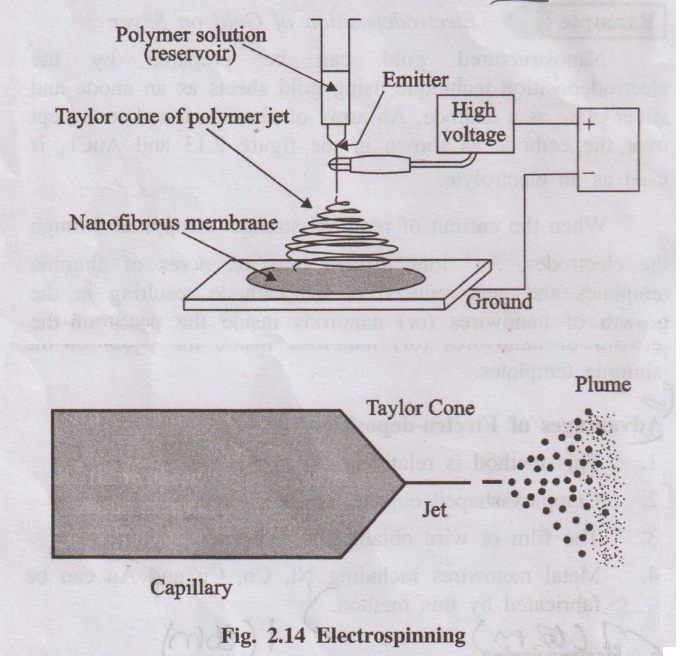
Fig. 2.14 Electrospinning
Process
A polymer is dissolved in a suitable solvent and is filled in the
capillary reservoir. When sufficiently high voltage is applied to create an
electric field between the needle tip and the collector, a charge accumulates
at the liquid surface. When the electrostatic repulsion is higher than the surface
tension the liquid meniscus is deformed into conically shaped structure known
as a Taylor cone.
Once the Taylor cone is formed, the charged liquid jet is ejected
towards the collector. Depending upon the viscosity of the solution, solid
fibre will be formed as the solvent evaporates.
Applications
1. Electrospinning is used in diagnosis and treatment of diabetes.
2. Electrospun fibres are used in energy storage devices such as,
solar cell, fuel cell, super capacitors.
3. It is also used in textiles for smart clothing, protecting clothing
and fire retardant fibres.
4. It is used in sensors like gas sensors, chemical sensors and
fluorescence sensors.
5. In biomedical, it is used in drug delivery, artificial blood vessel
and wound dressing.
6. e-spun fibres employed in a variety of applications such as
filtration and thermal insulation.
4. Applications of Nanomaterials
Nano-technology finds significant impact on all most all the
industries and all areas of society. Since nano-materials possess unique beneficial
chemical, physical and mechanical properties, they can be used for a wide
variety of applications.
I. Medicine
1. Nano drugs
Nano materials are used as nano drugs for the cancer and TB
therapy,
2. Laboratories on a chip
Nano technology is used in the production of laboratories on a
chip.
3. Nano-medibots
Nano particles function as nano-medibots that release anti-cancer
drug and treat cancer.
4. Gold-coated nanoshells
It converts light into heat, enabling the destruction of tumours.
5. Gold nano particles as sensors
Gold nano particles undergo colour change during the transition of
nano particles. .
6. Protein analysis
Protein analysis can also be done using nanomaterials.
7. Gold nanoshells for blood immuno assay
Gold nano shells are used for blood immuno assay.
8. Gold nano shells in imaging
Optical properties of the gold nano shells are utilized for both
imaging and therapy.
9. Targeted drug delivery using gold nano particles
It involves slow and selective release of drugs to the targeted
organs.
10. Repairing work
Nano technology is used to partially repair neurological damage.
II. In Agriculture
1. Nanomaterials prepared by eco-friendly and green method with
plant extracts (Nano formulations) could increase agriculture potential for
improving fertilization process, plant growth regulators.
2. They also minimize the amount of harmful chemicals that pollute
the environment.
3. Nanosensors are used in crop protection for the identification
of diseases and residues of agrochemicals.
4. Nanodevises are used for the genetic engineering of plants.
5. Nanomaterials are used in plant disease diagnostics.
6. It is also used in postharvest management.
7. Precision farming techniques might be used to further improve
the crop yields but not damage soil and water.
8. Some nanomaterials are used as antimicrobial agents in food
packing especially silver nanoparticles are in great interest.
9. Nano particle - based pesticides and herbicides are being
explored for the application of antimicrobial agents to protect crops from
various diseases.
III. In Energy
Nanomaterials are used in several applications to improve the
efficiency of energy generation (or) develop new methods to generate energy.
1. Power generation
Sun light, concentrated on nanoparticles, can produce steam with
high energy efficiency, which can even be used in running power plants.
2. Generating hydrogen from sea water
The use of a nanostructured thin film of nickel selenide as a
catalyst for the electrolysis of hydrogen from sea water.
3. Producing high efficiency light bulbs
Nano-engineered polymer matrix is used for the production of high
efficiency light bulbs.
4. Increasing the electricity generated by wind mills
Stronger and lower weight blades, made from nanotubes-filled
epoxy, in wind mills increases the amount of electricity.
5. Generating electricity from waste heat
Sheets of nanotubes have been used to build thermocells that
generates electricity, when the sides of the cell are at different temperature
6. Storing hydrogen for fuel cell powered cars
Graphene layers are used in fuel tank, resulting in a higher
amount of hydrogen storage and therefore lighter weight fuel tank.
7. Reducing power loss in electric transmission wires
The wires containing carbon nanotubes lowers resistance than the
wires currently used in the electric transmission grid.
8. Reducing the cost of solar cell
Nanotech solar cells are manufactured at significantly lower cost
than the conventional solar cells.
9. Nano battery and fuel cell
Nanomaterials, used in batteries and fuel cell, increases their
efficiency.
IV. Electronics
1. Quantum wires are found to have high electrical conductivity.
2. The integrated memory circuits have been found to be effective
devices.
3. A transistor, called NOMFET, (Nanoparticle Organic Memory Field
Effect Transistor) is created by combining gold nanoparticles with organic
molecules.
4. Nano wires are used to build transistors without p-n junctions.
5. Nano radios are the other important devices, using carbon
nanotubes.
6. MOSFET (Metal Oxide Semiconductor Field Effect Transistor),
performs both as switches and as amplifiers.
V. In Catalysis
Nanoparticle catalysts are highly effective because of the
following two reasons
(i) huge surface area
(ii) enhanced reactivity
1. Water purification
Nanosilver catalyst is highly efficient in controlling microbes in
water.
2. Bio-diesel production
Solid base nanocatalyst KF/CaO can be used for biodiesel
production with yield more than 96%.
3. Fuel cell application
Carbon supported electro-catalysts play an important role in fuel
cell.
4. In drug delivery
Carbon nanomaterials find more applications in biological fields.
CNTs may be suitable for bio-applications in bio recognition and
drug delivery systems.
5. Gold nanoparticles
It is an important catalyst in co-oxidation, epoxidation of
propylene, hydrogenation of unsaturated hydrocarbons.
6. Nanopowder silica catalyst (or) platinum nanoparticles exhibit
very strong catalytic activity for hydrolysation reactions.
7. Titania-based nanocatalysts are being increasingly used in
photocatalysis.
8. Nanocrystalline MgO particles act as an effective catalyst for
dehydrogeneration.
Engineering Chemistry: Unit II: Nanochemistry : Tag: Engineering Chemistry : - Preparation of Nanomaterials
Related Topics
Related Subjects
Engineering Chemistry
CY3151 1st Semester | 2021 Regulation | 1st Semester Common to all Dept 2021 Regulation
